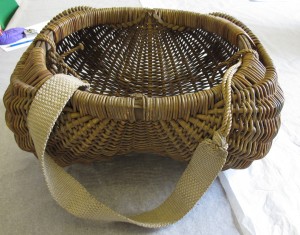The Arbroath rip, Liz Balfour’s account
The Arbroath rip was used by fisherwomen, carried on their backs for selling fish. It was never used at the harbour, but on women’s fish selling rounds or in the market. Rips are bigger than women’s arm creels (sometimes called fisher lassies’ baskets), which are also frame baskets and of similar form. The strap went across the breast. Liz remarks that some people say that straps were also worn across the forehead, but suggests this would seem to be a difficult way to carry the weight. The straps could also be worn over the shoulder, with the basket resting on the hips.
The construction of the Arbroath rip is extremely fine and very identifiable, to the point that one can hypothesize that some rips, at least, were probably made by the same maker. The frame around which the basket is formed is made from several overlapping bands of sawn wood which are very evenly bent into an oval. This even bending could only be achieved by an expert, and uses quite a different technology from most basketry skills, requiring the use of a steamer to bend the wood into a specific form. Liz suggests that these skills parallel those required for boat building, so that perhaps in Arbroath, basket makers worked alongside skilled joiners.
Most east coast baskets, from Berwick, to Dundee and Aberdeen, were made from rattan rather than local materials such as willow in more recent years. Rattan’s use for work baskets probably became popular in Scotland around the end of the 19th century. It was imported from around this period, used as a packing material around jute, in Liz’s view. It lasts much better in salt water in fishing baskets, and one can see from stored baskets in the museum that the rattan elements of a basket are much less fragile and last much longer than willow or other indigenous material. They are also much less susceptible to worm.
Even the ribs of a rip are made from rattan. One can see from the weave that they are added in pairs, one pair at a time, creating a pleasing pattern detail and finish to the frame top. The form of the basket, with two rounded ‘cheeks’, has sometimes earned them the name of ‘buttock baskets’ in the US, used there by migrants from Scotland. The detail of finishing is exquisite.
Rips made in Arboath were used by fishwives along the Angus coast, from Arbroath, to Ferry Den, Usan and Ethie Haven. They were probably in use from long before the growth of herring fishing in the late 1800s. Fishwives also sold white fish, sea-‘bottom feeders’, the products of long-line fishing, which was practised in the region before this.
Good examples of Arbroath rips are held at the National Museum of Scotland, and the Signal Tower Museum. They can also be seen on SCRAN.


